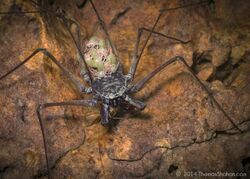Biology:Phrynidae
From HandWiki
Short description: Family of whip scorpions
| Phrynidae | |
|---|---|

| |
| Paraphrynus spp. with her young in Belize | |
| Scientific classification | |
| Domain: | Eukaryota |
| Kingdom: | Animalia |
| Phylum: | Arthropoda |
| Subphylum: | Chelicerata |
| Class: | Arachnida |
| Order: | Amblypygi |
| Family: | Phrynidae Thorell, 1883 |
| Genera | |
|
See text | |
Phrynidae is a family of amblypygid arachnida arthropods also known as whip spiders and tailless whip scorpions. Phrynidae species are found in tropical and subtropical regions in North and South America. Some species are subterranean; all are nocturnal.[1] At least some species of Phrynidae hold territories that they defend from other individuals.[2]
Taxonomy
The following genera are recognised:[3]
- Phrynidae Blanchard, 1852
- Acanthophrynus Kraepelin, 1899 (1 species)
- †Britopygus Dunlop & Martill, 2002 (1 species; Crato Formation, Brazil, Early Cretaceous (Aptian))
- †Electrophrynus Petrunkevich, 1971 Chiapas amber, Mexico, Miocene (nomen dubium)[4]
- Heterophrynus Pocock, 1894 (17 species)
- Paraphrynus Moreno, 1940 (18 species)
- Phrynus Lamarck, 1801 (28 species, Oligocene - Recent)
References
- ↑ Chapin, KJ; Hebets, EA (2016). "Behavioral ecology of amblypygids". Journal of Arachnology 44 (1): 1–14.
- ↑ Chapin KJ; Hill-Lindsay S (2015). "Territoriality evidenced by asymmetric intruder-holder motivation in an amblypygid". Behavioural Processes 122: 110–115.
- ↑ Mark S. Harvey (2003). "Order Amblypygi". Catalogue of the smaller arachnid orders of the world: Amblypygi, Uropygi, Schizomida, Palpigradi, Ricinulei and Solifugae. CSIRO Publishing. pp. 3–58. ISBN 978-0-643-06805-6. https://books.google.com/books?id=I5JNqiORopUC&pg=PA12.
- ↑ Dunlop, Jason A.; Mrugalla, Boris (2015). "Redescription of the Chiapas amber whip spider Electrophrynus mirus (Amblypygi)". The Journal of Arachnology 43 (2): 220–223. ISSN 0161-8202. https://www.jstor.org/stable/24717337.
External links
Wikidata ☰ Q3381696 entry
 |

